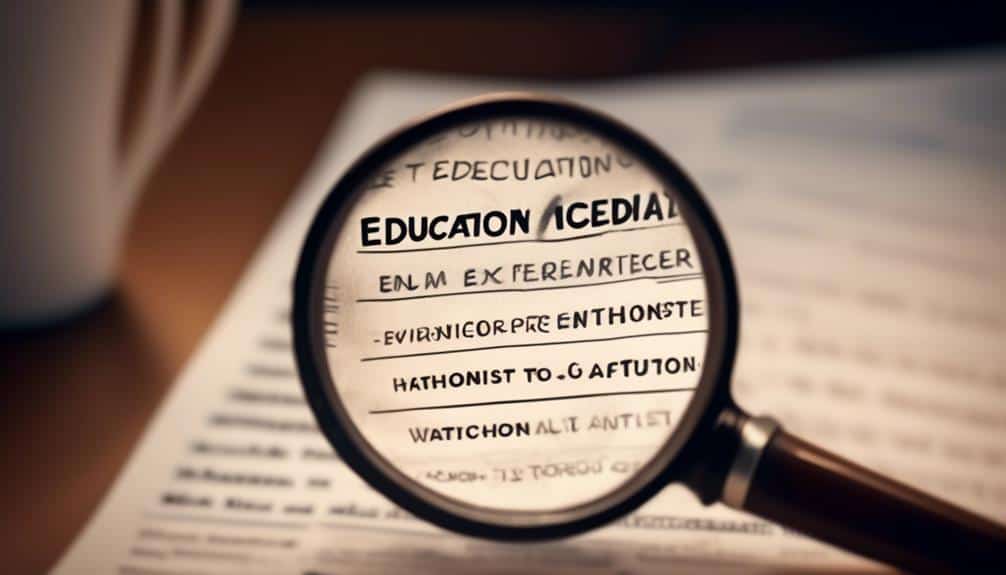Navigating the News: Techniques for Identifying Trustworthy Journalism
Ever found yourself knee-deep in the swamp of sensational news stories, wondering if you'll ever resurface with your trust in journalism intact? Well, fear not, as there are ways to navigate the murky waters of misinformation and emerge with a clearer view of what constitutes reliable reporting.
By honing in on key techniques for identifying trustworthy journalism, you can equip yourself with the tools needed to sift through the noise and find the signal of truth. So, grab a life vest and get ready to navigate the news landscape with confidence.
Key Takeaways
- Media ownership influences bias in news coverage, impacting stories covered, tone of reporting, and perspectives.
- Fact-checking is essential to verify sources and information accuracy in the face of rapid misinformation spread.
- Author credentials and track record of reporting play a significant role in determining the credibility of news sources.
- Assessing domain reputation, identifying clickbait articles, and scrutinizing headlines are crucial steps in evaluating the trustworthiness of journalism.
Understanding Media Bias

When evaluating news sources, understanding media bias is crucial for discerning the nuances that may influence the presentation of information. Media ownership plays a significant role in shaping the bias present in news coverage. Different media outlets are owned by various corporations or individuals, each with their own agendas and interests. This ownership can directly impact the stories covered, the tone of the reporting, and the perspectives presented to the audience.
Confirmation bias is another critical aspect to consider when analyzing media bias. People tend to seek out information that confirms their existing beliefs while disregarding or discrediting information that contradicts them. This cognitive bias can influence how news is consumed and interpreted, leading individuals to gravitate towards sources that align with their viewpoints.
Fact-Checking Tools and Resources
Fact-checking tools and resources are essential for verifying the accuracy and credibility of information presented in news articles and reports. In today's digital age, where misinformation can spread rapidly, having access to reliable fact-checking tools is crucial for discerning truth from falsehood.
- Machine Learning Algorithms: Advanced algorithms can help detect patterns of bias in news articles by analyzing language use, sources cited, and overall tone.
- Crowdsourced Fact-Checking Platforms: Platforms where users can contribute to fact verification processes help in cross-referencing information and identifying potential inaccuracies.
- Browser Extensions: Tools like browser extensions that flag potentially misleading content or sources can assist in real-time bias detection while browsing the web.
Evaluating Author Credentials

When evaluating author credentials, it's crucial to consider the author's relevant experience and verify their educational background. Understanding where the author is coming from and what expertise they bring to the table can help assess the credibility of their work.
Author's Relevant Experience
To ascertain the credibility of a journalist, it's essential to carefully evaluate the author's relevant experience in the field. When assessing an author's background, consider the following:
- Personal Anecdotes and Insights: Authors with firsthand experiences or unique insights into a subject matter can provide a deeper understanding and more nuanced perspective in their reporting.
- Industry Connections and Perspectives: Journalists who've established connections within the industry they're covering can offer valuable insider viewpoints and access to exclusive information.
- Track Record of Reporting: Review the author's past articles and investigative work to gauge their consistency, accuracy, and level of expertise in the field. A strong track record can indicate reliability and credibility in their reporting.
Educational Background Verification
Performing a thorough verification of an author's educational background is crucial in assessing their credentials and expertise in journalism. When evaluating an author's educational credentials, it's essential to verify the institutions they attended, the degrees obtained, and any specialized training related to journalism.
Look for reputable universities or colleges known for their strong journalism programs. Additionally, check if the author has pursued any continuing education courses or certifications in the field.
Cross-Referencing Information
Cross-referencing information from multiple credible sources is essential in verifying the accuracy and reliability of journalism. When you cross-reference sources, you enhance your understanding of the news landscape and make more informed decisions about what to trust. Here are some key points to remember:
- Diverse Perspectives: Cross-referencing allows you to gather information from various viewpoints, helping you form a more comprehensive understanding of the topic.
- Fact-Checking: By comparing details across different sources, you can identify discrepancies or inconsistencies that may raise red flags about the accuracy of the information.
- Confirmation of Facts: When multiple reputable sources corroborate the same information, it adds weight to the validity of the news piece, increasing your confidence in its reliability.
In a time where misinformation spreads rapidly, the practice of cross-referencing sources remains a fundamental tool for ensuring the trustworthiness of the news you consume.
Assessing Domain Reputation

Amidst the practice of cross-referencing information to ensure the credibility of news sources, an additional crucial step involves assessing the reputation of the domains hosting the news content. Evaluating website authority and domain credibility are essential aspects of determining the trustworthiness of the news you consume. Websites with a strong reputation for accuracy, fact-checking, and unbiased reporting are more likely to provide reliable information. Look for well-established domains that have a history of producing high-quality journalism and are recognized for their credibility in the industry.
When assessing domain reputation, consider the website's track record, the expertise of its writers, and whether they cite credible sources to back up their claims. Additionally, examine if the domain is affiliated with any known biases or has a history of spreading misinformation. By scrutinizing the reputation of the domains you encounter, you can make more informed decisions about the news you choose to trust and share.
Analyzing Article Structure
Assessing the structural organization of an article plays a crucial role in evaluating its effectiveness and credibility. When analyzing article structure, it's essential to identify patterns and dissect arguments to determine the quality of the content. Here are three key points to consider:
- Introduction: The opening of an article should provide a clear thesis or main argument, setting the tone for the rest of the piece. Analyzing how well the introduction captures the reader's attention and presents the article's purpose can give insights into the overall quality of the content.
- Body: The body of the article should present evidence, examples, and analysis to support the main argument. By dissecting how well the arguments are supported and the logical flow of information within the body, you can assess the strength of the article's content.
- Conclusion: The conclusion should summarize key points and reiterate the main argument. Evaluating how effectively the conclusion reinforces the main ideas and leaves a lasting impression on the reader can indicate the article's overall coherence and persuasiveness.
Recognizing Clickbait Techniques

To recognize clickbait techniques effectively, you must be vigilant in identifying sensationalized elements within headlines and content. Clickbait often relies on exaggerated or misleading information to grab your attention. One way to identify red flags is to look for headlines that evoke strong emotions or curiosity without providing substantial information. Phrases like 'you won't believe' or 'shocking news' are common clickbait tactics designed to entice you to click without offering meaningful content.
Avoiding sensationalism requires a critical mindset. Before clicking on a headline, assess whether the information seems too good to be true or overly dramatic. Clickbait articles often prioritize generating clicks over providing accurate or valuable information. By being aware of these tactics, you can make more informed choices about the content you engage with.
Verifying Sources and Citations
When verifying sources and citations, it's crucial to apply source evaluation criteria to assess their reliability.
Cross-referencing information from multiple reputable sources can help confirm the accuracy of the content.
Source Evaluation Criteria
Effective evaluation of sources and citations is crucial for ensuring the credibility and reliability of journalism. When assessing sources, consider the following:
- Bias Detection: Look for any potential biases that could influence the information presented.
- Credibility Assessment: Evaluate the credibility of the author or organization providing the information.
- Cross-Verification: Verify the information with multiple reputable sources to ensure accuracy.
Cross-Referencing Information
Cross-referencing information is a fundamental practice in journalism that ensures the accuracy and reliability of sources and citations. Information verification plays a crucial role in establishing the credibility of a news article. By cross-referencing data from multiple sources, journalists can confirm the validity of their information and detect any inconsistencies or biases.
This process not only strengthens the credibility of the news but also enhances transparency and trustworthiness. When cross-referencing information, it's essential to compare details, check for corroborating evidence, and validate the sources' credibility. By adopting a rigorous approach to data cross-referencing, journalists can uphold the integrity of their work and provide audiences with accurate and reliable news content.
Scrutinizing Headlines and Titles

To evaluate the credibility of news sources, you must carefully analyze the language used in headlines and titles. When scrutinizing headlines and titles, keep in mind the following:
- Analyzing Tone: Pay close attention to the tone of the headline or title. Is it neutral and informative, or does it seem sensationalized or exaggerated? A neutral tone often indicates a more objective approach to reporting.
- Uncovering Bias: Look for any signs of bias in the language used. Biased language can sway your perception of the news, so it's crucial to identify any subtle hints of partiality towards a particular viewpoint.
- Checking for Clickbait: Be wary of titles designed to attract clicks rather than provide accurate information. Sensational or misleading headlines may indicate a lack of credibility in the reporting.
Engaging in Critical Thinking
Engage in critical thinking by evaluating sources with a discerning eye and questioning the validity of information presented. Critical analysis involves delving beyond the surface of an article to assess the credibility of the content. When engaging with news, apply logical reasoning to decipher whether the sources cited are reputable and whether the information aligns with known facts. By actively questioning the sources and investigating their reliability, you can better determine the accuracy of the news you encounter.
To enhance your critical thinking skills further, consider the context in which the information is presented. Evaluate whether the article provides sufficient evidence to support its claims and whether it offers a balanced perspective on the topic. By engaging in thorough critical analysis, you can navigate the vast landscape of news more effectively, distinguishing between trustworthy journalism and biased or misleading content. Remember, logical reasoning is your tool to sift through the noise and find the signal of truth within the news media.
Frequently Asked Questions
How Can I Determine the Credibility of a News Outlet Based on Its Ownership and Funding Sources?
To determine a news outlet's credibility based on ownership and funding, you should assess ownership transparency and funding sources. Look for bias indicators and examine fact-checking practices. These elements offer insight into the outlet's reliability.
Is There a Way to Track the History of Corrections or Retractions Made by a Particular News Source?
To track a news source's corrections or retractions, utilize fact-checking tools like NewsGuard or Media Bias/Fact Check. Verify claims with multiple reliable sources. Evaluate the source's transparency and editorial standards to ensure credibility.
Are There Any Specific Red Flags to Look Out for When Evaluating the Expertise and Qualifications of an Author?
When evaluating author credentials, watch for red flags like lack of relevant expertise, biased affiliations, or undisclosed conflicts of interest. Verify qualifications through reputable sources to ensure the author's credibility and expertise.
How Can I Confirm the Accuracy of Information by Comparing It With Multiple Reputable Sources?
To confirm accuracy, cross-reference articles from various reputable sources. Use fact-checking resources and verification tools for added assurance. Comparing sources enhances credibility and ensures you're relying on reliable information.
What Steps Can I Take to Assess the Reputation of a Website's Domain in Terms of Reliability and Trustworthiness?
To assess a website's domain reputation for reliability and trustworthiness, you can investigate its funding sources and ownership. By examining these factors, you can gauge the accuracy of the information presented on the site.
Conclusion
In conclusion, navigating the news can be a challenging task in today's media landscape. By utilizing techniques such as:
- Understanding media bias
- Fact-checking tools
- Evaluating author credentials
- Cross-referencing information
- Assessing domain reputation
- Recognizing clickbait techniques
- Verifying sources
- Scrutinizing headlines
- Engaging in critical thinking
You can identify trustworthy journalism and make informed decisions about the information you consume. Stay vigilant and critical in your approach to consuming news to ensure you're getting accurate and reliable information.








